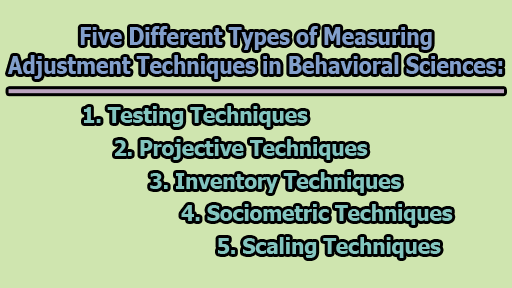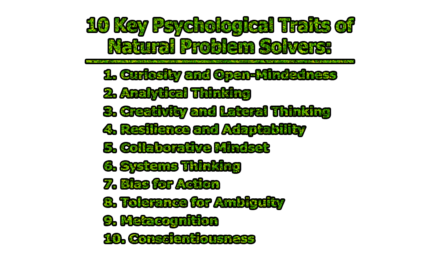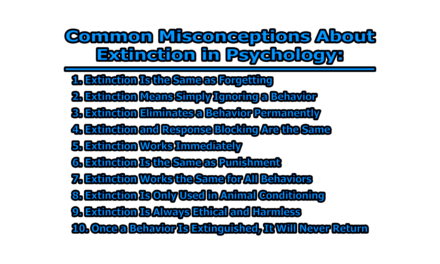Five Different Types of Measuring Adjustment Techniques in Behavioral Sciences:
In the realm of behavioral sciences, understanding and measuring adjustment are essential components of psychological research and practice. Various techniques have been developed to assess and quantify the complexities of human adjustment. Here, we delve into five different types of measuring adjustment techniques in behavioral sciences:
1. Testing Techniques: Testing techniques in behavioral sciences involve the use of standardized assessments to evaluate specific aspects of an individual’s cognitive abilities, personality traits, or other psychological constructs related to adjustment. These assessments are carefully designed with established norms to ensure reliability and validity in measuring various dimensions of human behavior and functioning.
Examples:
- Intelligence Tests: Intelligence tests, such as the Wechsler Adult Intelligence Scale (WAIS) or Stanford-Binet Intelligence Scales, are designed to measure cognitive abilities, including problem-solving, reasoning, and memory. These tests provide an overall IQ score and may include subtests to assess specific cognitive domains.
- Personality Tests: Personality tests, such as the Minnesota Multiphasic Personality Inventory (MMPI), aim to measure personality traits, emotional adjustment, and psychopathology. These tests typically involve self-report questionnaires where individuals respond to statements that reflect their thoughts, feelings, and behaviors.
Application:
- Educational Settings: Testing techniques are frequently used in educational settings to identify learning disabilities, assess intellectual strengths and weaknesses, and inform educational interventions. For example, a school psychologist might administer an intelligence test to determine a student’s cognitive abilities.
- Clinical Psychology: In clinical psychology, testing techniques play a crucial role in assessing and diagnosing mental health conditions. Personality tests can provide insights into an individual’s emotional adjustment, helping psychologists tailor therapeutic interventions.
Testing techniques contribute to a standardized and objective approach in assessing various psychological dimensions. These assessments provide valuable information for educational planning, clinical diagnosis, and research endeavors in the behavioral sciences. The rigorous design of these tests ensures that results are consistent, allowing for meaningful comparisons across individuals and populations.
2. Projective Techniques: Projective techniques in behavioral sciences aim to uncover underlying emotions, thoughts, and attitudes by presenting individuals with ambiguous stimuli. The belief underlying these techniques is that individuals will project their unconscious feelings and thoughts onto the ambiguous stimuli, offering insights into aspects of their personality and adjustment that may be less accessible through direct questioning.
Examples:
- Rorschach Inkblot Test: This projective test involves presenting individuals with inkblot images and asking them to describe what they see. The responses are then analyzed to gain insights into the individual’s thought processes, emotions, and potential psychological issues.
- Thematic Apperception Test (TAT): TAT involves showing individuals a series of ambiguous pictures and asking them to create a story based on each image. The stories generated are thought to reflect the individual’s perceptions, concerns, and conflicts.
Application:
- Psychotherapy: Projective techniques are often used in therapeutic settings to explore unconscious conflicts and emotions. Psychologists and therapists may employ these methods to uncover aspects of a person’s adjustment that may be hidden or not easily expressed.
- Research: While less common in quantitative research, projective techniques can be valuable in qualitative studies exploring subjective experiences and perceptions. Researchers may use these techniques to gather rich, in-depth information about individuals’ adjustment processes.
Projective techniques offer a unique window into the unconscious mind, allowing psychologists to explore aspects of adjustment that may be challenging to access through more direct methods. While interpretations can be subjective, skilled practitioners can glean valuable insights into an individual’s emotional world and coping mechanisms using these techniques.
3. Inventory Techniques: Inventory techniques in behavioral sciences involve the use of standardized questionnaires or checklists to measure specific traits, behaviors, or symptoms related to adjustment. These self-report assessments provide quantitative data and are designed to gather information about an individual’s psychological state, well-being, or specific areas of concern.
Examples:
- Beck Depression Inventory (BDI): The BDI is a widely used inventory that assesses the severity of depressive symptoms. Individuals respond to a series of statements about their feelings, and scores are tallied to indicate the level of depressive symptoms.
- State-Trait Anxiety Inventory (STAI): The STAI measures both state and trait anxiety. It consists of separate scales to assess the temporary experience of anxiety (state anxiety) and the more enduring characteristic of anxiety (trait anxiety).
Application:
- Clinical Assessment: Psychologists and clinicians use inventory techniques to assess symptoms, diagnose mental health conditions, and track changes over time. For example, a therapist might use a depression inventory to monitor a client’s progress during treatment.
- Research: Inventory techniques are widely employed in research settings to collect quantitative data on various psychological constructs. Researchers may use inventories to investigate the prevalence of certain traits or symptoms within a population.
Inventory techniques provide a standardized and efficient way to gather data on specific psychological variables. They are particularly useful for large-scale studies, allowing researchers to quantify and compare individuals’ responses across different groups or conditions. Additionally, inventories are valuable tools in clinical settings, aiding in the diagnostic process and treatment planning.
4. Sociometric Techniques: Sociometric techniques in behavioral sciences focus on measuring social interactions and relationships within a group. These techniques help assess social adjustment, popularity, and the quality of interpersonal connections. They provide a quantitative understanding of an individual’s social standing within a particular environment.
Examples:
- Sociograms: Sociograms visually represent social networks within a group, illustrating the relationships and interactions among group members. The structure of the sociogram can reveal patterns of friendship, influence, and social dynamics.
- Peer Nomination Surveys: These surveys ask individuals within a group to nominate peers based on certain criteria, such as popularity, helpfulness, or likeability. The data collected from these surveys provide insights into social preferences and group dynamics.
Application:
- Educational Settings: Sociometric techniques are often employed in schools to understand social dynamics among students. Identifying patterns of friendship or social isolation can guide interventions to improve the overall social climate.
- Therapeutic Contexts: Psychologists may use sociometric assessments in therapeutic settings to explore an individual’s interpersonal relationships and identify potential sources of stress or support.
Sociometric techniques offer a systematic approach to understanding social structures and relationships. By quantifying social interactions, psychologists and researchers can gain insights into the dynamics of groups, helping to identify potential areas for intervention and support.
5. Scaling Techniques: Scaling techniques involve the measurement of attitudes, opinions, or preferences along a defined scale. These techniques provide a quantitative representation of subjective experiences or perceptions, allowing researchers and practitioners to assess the intensity or magnitude of a particular construct.
Examples:
- Likert Scales: Likert scales present individuals with a statement and ask them to rate their agreement or disagreement on a numerical scale (e.g., strongly agree to strongly disagree). These scales are widely used in research to measure attitudes, opinions, and preferences.
- Visual Analog Scales (VAS): VAS use a continuous line or numerical scale to assess the intensity of a subjective experience, such as pain, mood, or satisfaction. Participants mark their position on the scale to indicate the degree of their experience.
Application:
- Research: Scaling techniques are employed in research to quantify subjective experiences and gather data on individuals’ perceptions. Researchers may use Likert scales to measure the impact of an intervention or assess attitudes toward a particular topic.
- Clinical Assessment: In clinical settings, scaling techniques can be used to assess the intensity of symptoms, the effectiveness of treatment, or changes in an individual’s well-being over time.
Scaling techniques offer a quantitative approach to measuring subjective experiences, providing numerical data that can be analyzed and compared. These techniques are versatile and can be adapted to assess a wide range of psychological constructs in both research and clinical contexts.
In conclusion, the measurement of adjustment in behavioral sciences is a nuanced process that requires a variety of techniques to capture the multidimensional nature of human behavior and experience. Testing techniques, projective techniques, inventory techniques, sociometric techniques, and scaling techniques each offer unique insights and contribute to a comprehensive understanding of an individual’s adjustment. Researchers and practitioners often combine these methods to gather diverse data, providing a more holistic view of psychological well-being and adjustment in different contexts.

Assistant Teacher at Zinzira Pir Mohammad Pilot School and College










